Family : Salamandridae

Text © Dr. Nicolò Pellecchia

English translation by Mario Beltramini
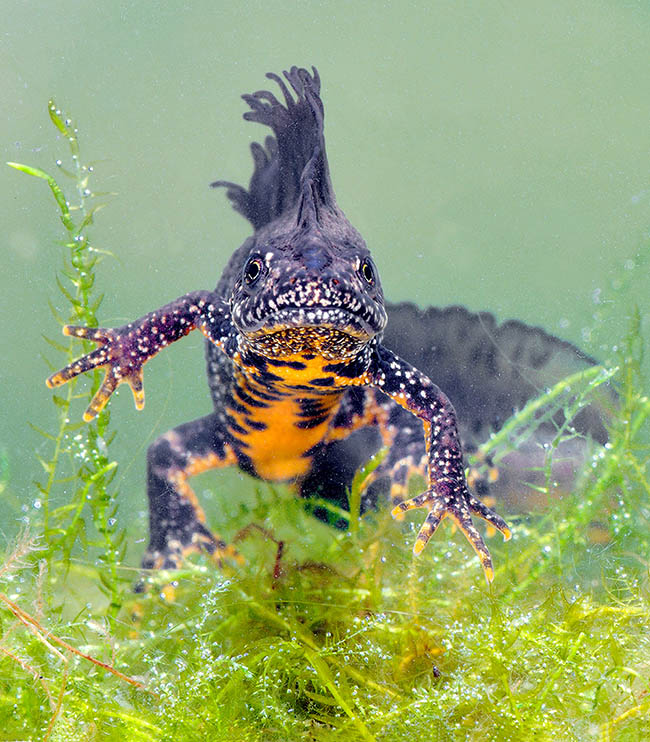
Present in all central-northern Europe, Triturus cristatus colonizes to reproduce in various aquatic environments © Natuurpunt-Hugo Willocx
Present in all central-northern Europe, the Northern crested newt Triturus cristatus (Laurenti,1768), is an amphibian belonging to the order of the Caudata and to the family of the Salamandridae.
The generic term Triturus comes from the Latin “Triton”, Triton, son of the god of the sea Poseidon and of the Nereid Amphitrite.
The specific epithet cristatus, with the crest in Latin, takes us back to its most striking feature, the majestic crest of the males.
Zoogeography
Triturus cristatus is a species with a very vast distribution range.
The westernmost populations are the French and English ones, and is present all over central and northern Europe, reaching, north, Scandinavia, and south, Switzerland, Austria and the Balkans.
East, it can be seen up to the Ural Mountains and Western Siberia.
Presently we count in Europe six species assigned to the genus Triturus, like for instance, in Italy, Triturus carnifex, but until two decades ago, they were all considered Triturus cristatus.
Ecology-Habitat
The Northern crested newt lives mainly in the plains and in the hills between 200 and 600 m. More rare are the populations reaching the 1000 m, with altitudinal records of about 1700 m.
Triturus cristatus and the other species of this genus tend to be more aquatic than the other European newts, like, for instance, Ichthyosaura alpestris.
The aquatic phase of the Northern crested newt lasta usually 4-5 months, and it can happen that the individuals still sexually immature spend the whole reproductive season in the water.
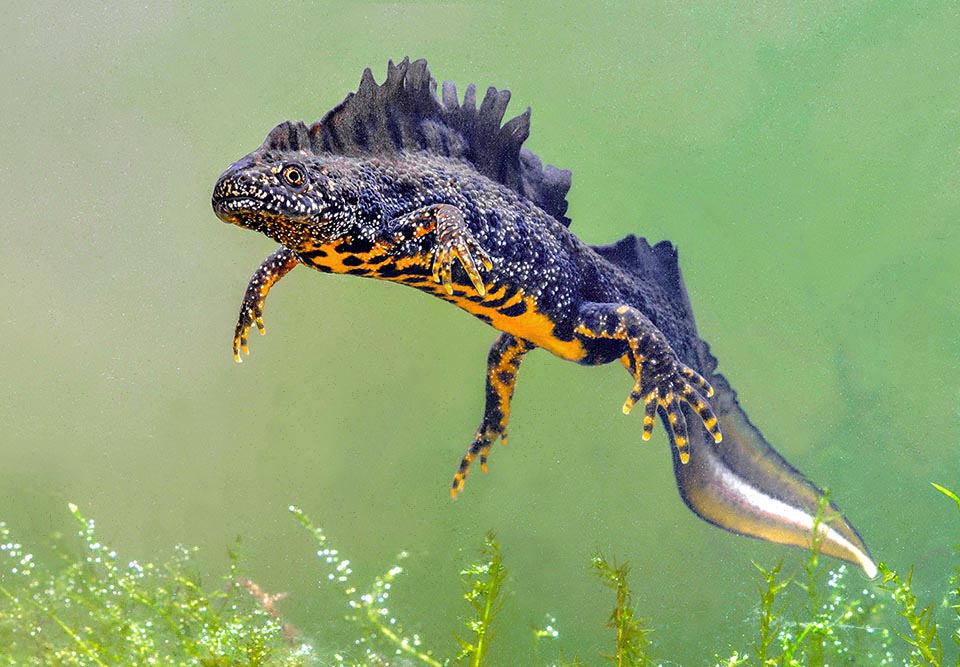
In that time the males show an even 15 cm rall crest, interrupted at the base of the tail that appears adorned by a luminous silvery-whitish band © Natuurpunt-Hugo Willocx
It colonizes a wide range of aquatic sites, like lakes, pits, artificial reservoirs and flooded grasslands, but tendentially, compared to the other species of newts, selects larger and deeper water bodies. Triturus cristatus is the only newt for whom the presence of submerged aquatic plants is a fundamental requirement for the eggs laying.
The terrestrial phase of many urodeles is difficult to study and also in the case of this species few data are available, that however seem to prove a preference for the deciduous forests and mixed woods not far from the reproductive sites.
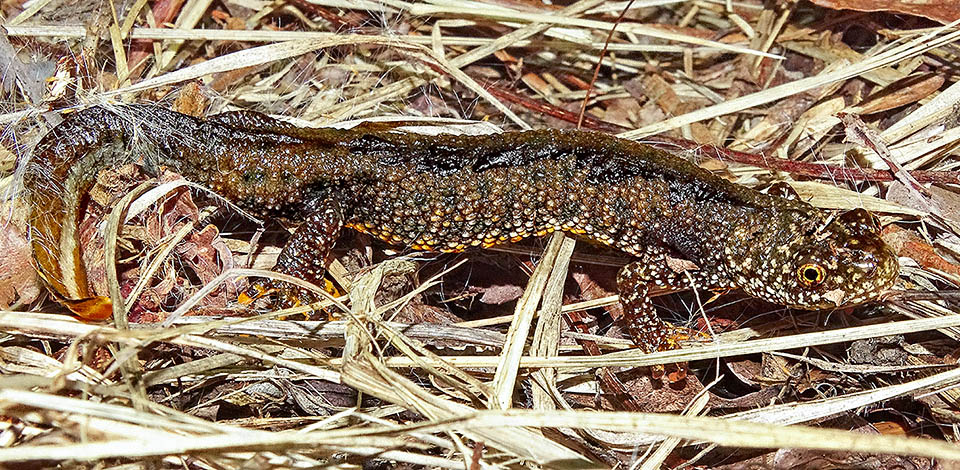
Much more modest is their look in the terrestrial phase they spend in deciduous forests or mixed woods not far from the reproduction sites © Julian Hodgson
Morphophysiology
Triturus cristatus can reach important dimensions, with a maximum length of 20 cm. The standard sizes however are usually more modest: 12-13 cm for the females weighing 8-10 g and 11-12 cm for the males with 6-9 g.
The colouration of the back ranges from brown with dark spots up to black, and the sides are characterized by a high number of white small dots. The throat is black and yellow with the same stippling as the sides.
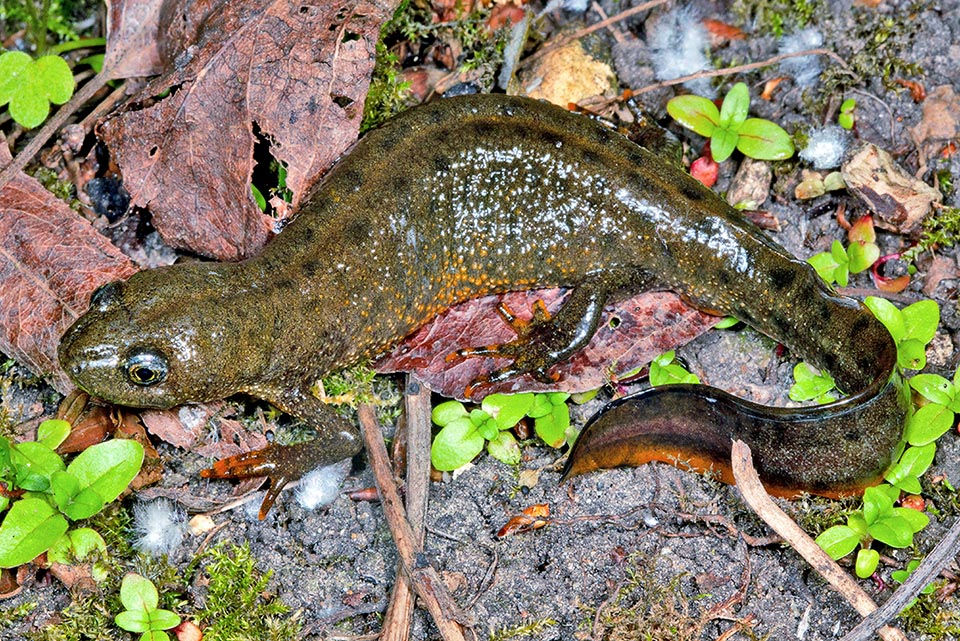
Female in underwood. We note the dark spots on the back present in both sexes. It does not have the crest of the male but the tail is longer and exceeds it also in weight © Todd Pierson
During the terrestrial phase the back of the Northern crested newt is completely black and the skin has a velvety texture.
The belly is orange-reddish or faded yellow, with the presence of black spots that create a unique pattern per each individual, like our fingerprints.
As for the other species of the genus Triturus there is a marked sexual dimorphism.
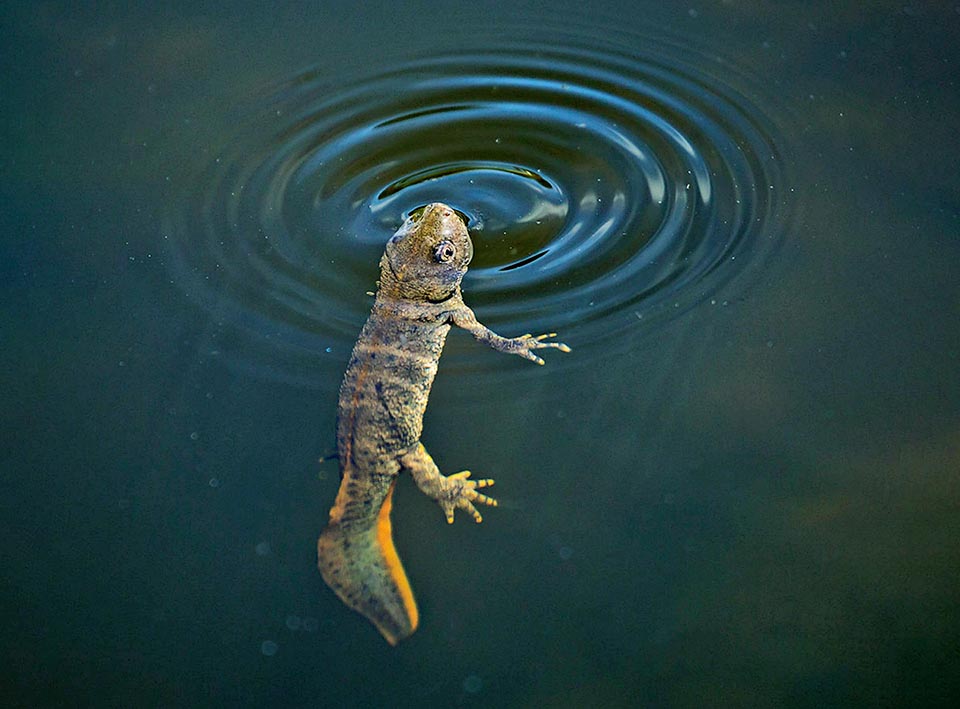
This female surfaces to breathe in a pond. Triturus cristatus spends 4-5 months in water deeper than those frequented by the newts belonging to different genera © Peter Warne
In addition to the different sizes, the males have in fact a showy crest, flaunted in the mating season, that reaches 15 mm in height, that they show off during that time, that stops at the base of the tail, adorned with a silvery-white band more intense towards the tip.
In the females these characters are less marked. Apart from the absence of the crest, replaced by a brownish line, at times also yellow, we can recognize them by the larger size of the tail, and for the different colourations of the cloaca, that usually has the same colour as the belly, whilst in the males is black.
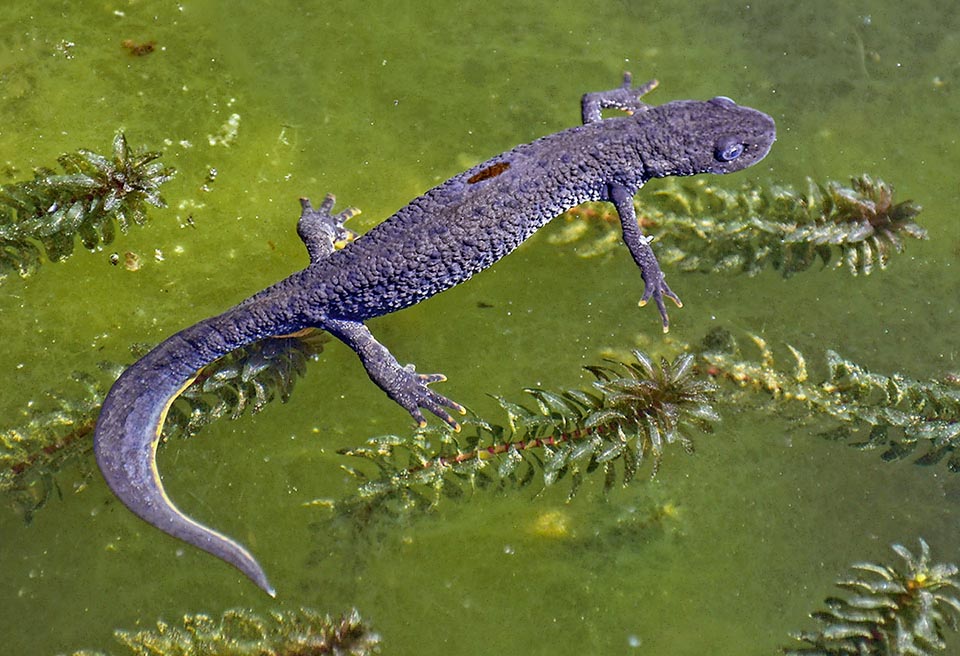
Here swims on surface searching insects and mollusks, but preys also other amphibians eggs and larvae © Joan Thirlaway
Ethology-Reproductive Biology
Triturus cristatus mainly feeds on invertebrates, among which various arthropods, earthworms and mollusks.
There have been observed instances of cases of predation also on eggs and larvae of other amphibians, such as smaller newts or tadpoles of anurans. The main predators of this species are the herons, the water snakes and the fishes.
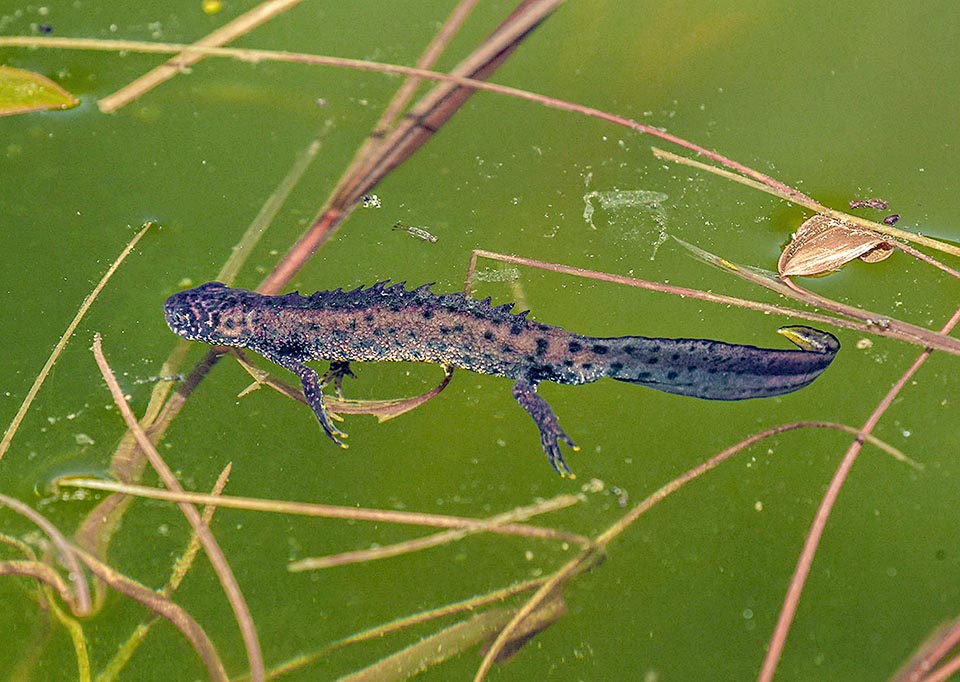
A male joins her. Fecundation is underwater with a precise ritual, where the male stands up majestically on its front legs and whips the female with the tail © Chris Rowland
Due to their slowness when facing a predator, these amphibians rarely escape, but the Northern crested newt has developed various anti-predatory strategies, like vocalizations, bite and postures that display the flaming ventral colouration that reminds its toxicity.
For instance, we find this behaviour well accentuated in anurans like the Yellow-bellied toad (Bombina variegata) or in other urodelians like the Northern spectacled salamander (Salamandrina perspicillata).
Triturus cristatus reproduces in water and lays eggs between March and June.
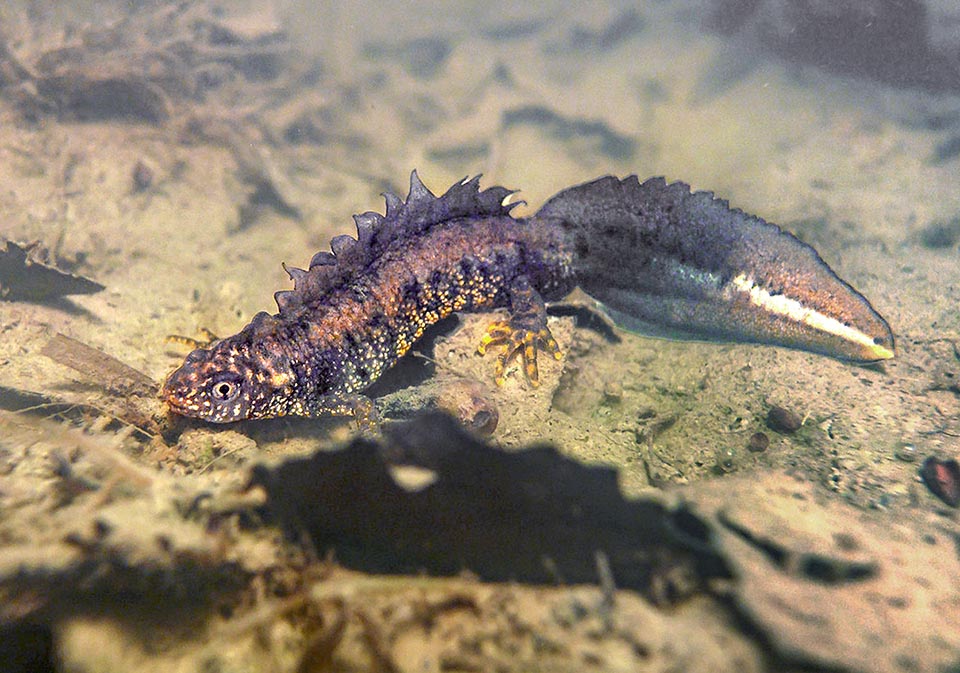
If this agrees che touches the male tail with snout and the male lays on bottom a capsule full of spermatozoa, the spermatophore, that the female introduces in the cloaca © Tomáš Klacek
For this species are known mating rituals, where tendentially the male tries to show off its features, like the high crest or the silvery tail, for attracting the females.
Once met, the male stands in front of the female and makes precise movements to show its boldness. For instance, it whips her with its tail or stands up on its front legs to look bigger. If the female backs away, the male follows her repeating the ritual.
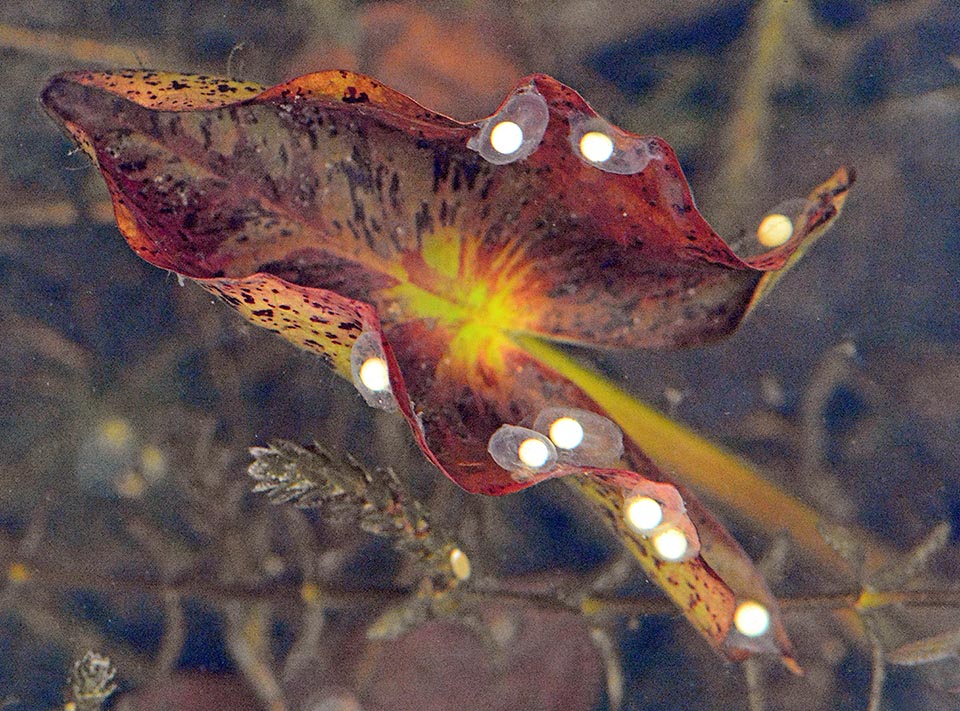
The eggs are glued to aquatic plants with big leaves that hide them from the sight of the predators © Will Atkins
When she finally agrees, touches the tail of the male with the snout and then it lays on the bottom a spermatophore, its capsule containing the spermatozoa.
The partner positions herself above and absorbs it from the cloaca.
The female lays eggs about 3 weeks after the mating, in a period varying from 1 to 3 months, with a total of 200-400 eggs per season.
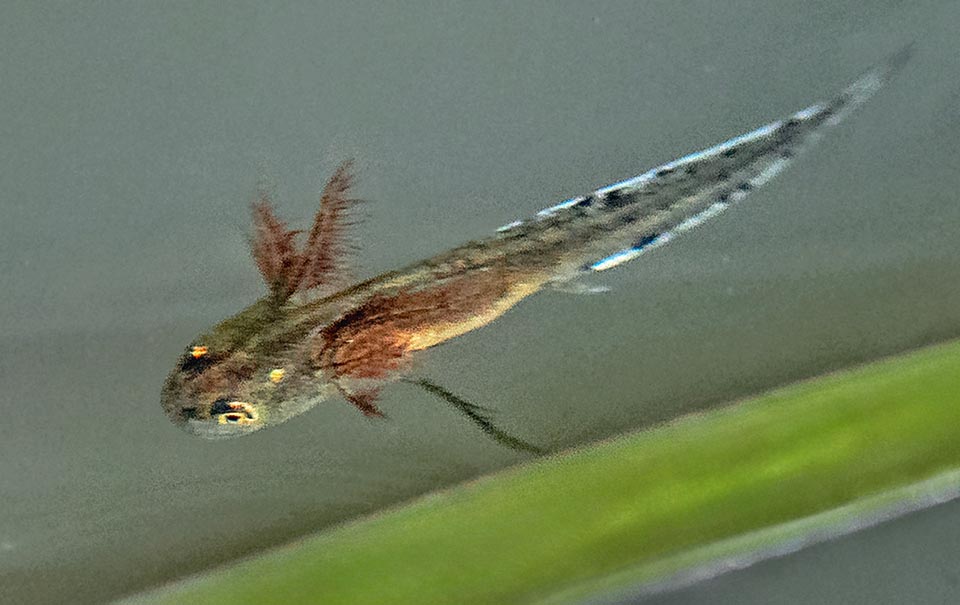
Upon birth the larvae measure 10-11 mm. They breathe with the gills and grow by eating microorganisms. Then they prey insects larvae and other small water invertebrates © Dalia Račkauska
Like all European newts also this species attaches them individually to leaves of aquatic plants, but seeing the large size of the egg, that measures about 6 mm, the Northern crested newt chooses plants with big leaves that moreover hide them from the sight of the predators.
From the eggs come to life larvae of about 10-11 mm, equipped with gills for breathing during the aquatic life, that metamorphose after 2-4 months, reabsorbing them, whann they reach 45-70 mm.
The instances of pedomorphosis, that is the retention of juvenile traits even when adult, are fairly rare compared to other European newts.
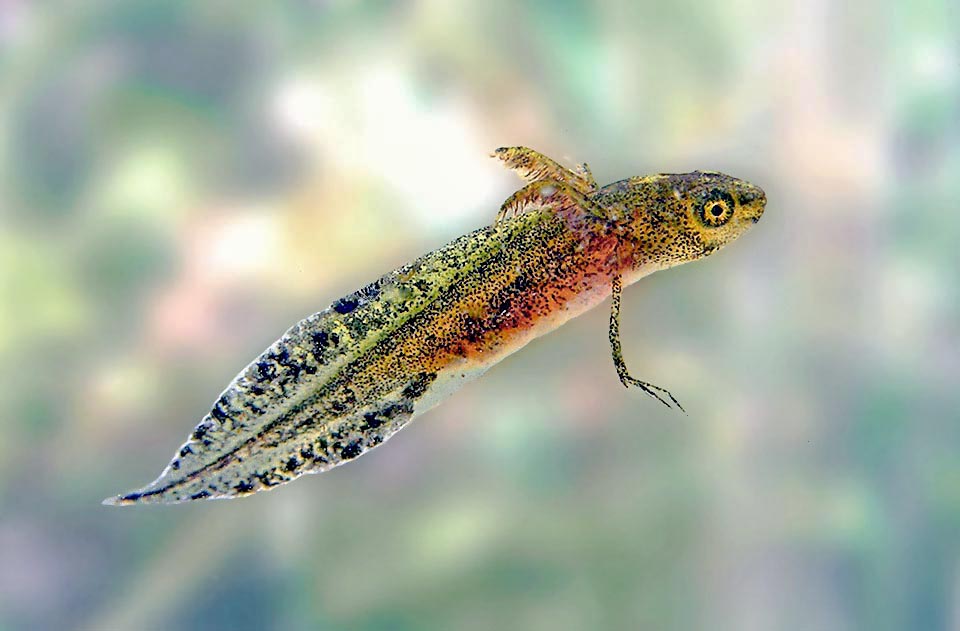
The metamorphosis with gills loss occurs after 2-4 months, when larvae have reached 45-70 mm. In nature a Triturus cristatus may live even 5-6 years © Merike Linnamägi
In nature the average age of a Triturus cristatus is 5 to 6 years. The populations are globally in decline but it still appears as “Least Concern“, that is at low riskin in the IUCN Red List of the endangered species.
Synonyms
Lacertus aquatilis Garasault, 1764; Triton cristatus Laurenti, 1768; Turanomolge mensbieri Nikolosky, 1918; Triton blasii De L’Isle, 1862; Triton trouessarti Peracca, 1886.
→ For general notions about Caudata please click here.
→ To appreciate the biodiversity within the SALAMANDERS please click here.
